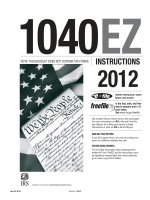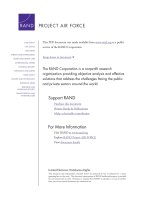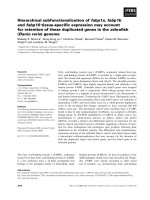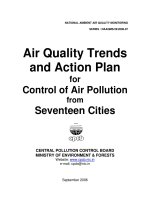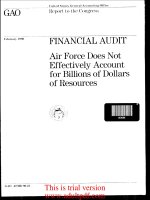FINANCIAL AUDIT Air Force Does Not Effectively Account for Billions of Dollars_part8 potx
Bạn đang xem bản rút gọn của tài liệu. Xem và tải ngay bản đầy đủ của tài liệu tại đây (915.85 KB, 12 trang )
Appendix I
Consolidated Financial Statements of the U.S.
Air Focw for the Fbcal Year Ending
September SO, 1988
B.
Recognition of Revenue and Financing
Sources
Financing sources for general funds are provided through
congressional appropriations which are received on both annual
and multi-year bases. Currently, the congressional budgetary
process under which the Air Force operates does not
distinguish between capital and operating expenditures.
For
budgetary purposes, both are recognized as a
use
of
resources
(outlays).
For financial reporting purposes under accrual
accounting, operating expenses for general fund activities are
recognized in the period incurred.
Expenditures for capital
and other long-term assets are not recognized as expenses until
consumed in the Air Force's operations. Unexpended
appropriations are recorded as equity of the U.S. government.
Certain expenses, such as annual and military leave earned but
not taken, are not funded when accrued. Such expenses are
financed in the period in which payment is required,
Therefore, for Air Force general funds, an amount due from
future financing sources (appropriations to be provided) is
recognized
as
an asset in the consolidated statement of
financial position which is comprised of the accrued amount of
such expenses at year-end.
The Air Force operates two types of revolving funds,
industrial and stock, for the purpose of distributing services
and inventories to Air Force and DOD activities.
Revenue for
industrial fund activities is recognized at the point the
rendered service is completed and on a percentage of physical
completion basis.
Revenue for stock fund activities is
recognized at the point the inventory items are sold.
The Air Force performs certain services for other governmental
and public entities. These services are initially financed
through general funds and subsequently reimbursed by the
recipients. Reimbursements are recognized as revenue at the
time
the services are rendered.
C. Funds with U.S. Treasury
Air Force fund resources
are
maintained in Treasury accounts.
Its cash receipts and disbursements are processed
by
the
Treasury,
and the balance with the
Treasury
represents the
aggregate of all
unexpended balances. As of September 30,
1988, the Air Force had $49,137 million in funds with the
Treasury which were available to pay outstanding obligations.
D.
Inventories
Inventories, including operating supplies and non-consumable
items,
are valued at standard prices established
by
the Air
Force or the Defense Logistics Agency as required by
DOD
Page 84
GAO/AFMD-90-23Air ForceFinancialAudit
This is trial version
www.adultpdf.com
Appendix I
Consolidated Financial Statements of the U.S.
Air Force for the Fiscal Year Endlng
September 30,1938
-
,
/
accounting directives. Generally, these prices are based on
prices paid for recently acquired items plus appropriate
surcharges. Gains and losses that result from standard price
changes for stock fund items are recognized and reported in
the statement of operations as miscellaneous revenues or
expenses. In 1988, the stock funds recorded
a
net loss of
$59.7 million, while the industrial funds recorded a loss of
$2.4 million due to changes in standard prices. No gains or
losses are recognized in the consolidated statement of
operations as
a
result of changes in standard prices for
general fund inventories.
Such changes are reflected in the
asset valuations and related invested capital as reported in
the statement of financial position.
E.
Property, Plant, and Equipment
Valuations for equipment, aircraft,
missiles, and engines are
not based on historical procurement costs.
These assets are
valued and reported at standard or average procurement costs
in conformance with
DOD
accounting directives.
Equipment is valued at standard costs which the Air Force
establishes using federal stock categories.
While no gains or
losses are recognized in the statement of operations for
changes in standard costs of equipment, such changes are
reflected in asset valuations and related invested capital.
Aerospace vehicles (aircraft and missiles) are valued at
average procurement costs. Engineering and modification costs
incurred subsequent to approval of the basic procurement
contracts are not capitalized unless such modifications and
engineering changes result in a new category of weapon system
commonly referred to as "mission, design, series," or
MDS.
Land and facilities are valued at cost.
Buildings are
capitalized when constructed or at the date of acquisition and
are assigned useful lives of 40 years.
Building improvements
costing more than $5,000 are capitalized and depreciated over
the remaining useful life of the building.
Routine maintenance and repair costs are expensed when
incurred. Depreciation of property and equipment is
calculated on a straight-line basis.
Industrial funds record
depreciation on buildings and equipment as required by Title 2
for revolving fund activities.
While Title 2 does not
specifically require depreciation on general fund assets,
depreciation is recorded on Air Force's aircraft and
buildings.
No depreciation has been recorded for other
general fund equipment and missiles (see note 4).
*
_
Page 86
GAO/AFMD-90-23 Air Force Financial Audit
This is trial version
www.adultpdf.com
Appendix I
Consolidated Financial Statements of the U.S.
Air Force for the Fiscal Year Ending
&ptember 30,1988
-/
F.
Accrued
Leave
Civilian annual leave and military leave are accrued as earned
and the accrued
amounts are
reduced as leave is taken.
The
balances for annual and military leave at the end of the
fiscal year reflect current pay rates for the leave that is
earned but not taken.
Sick and other types of leave are
expensed
as
taken.
G.
Foreign Currency Transactions
The Air Force conducts
a
significant portion of its operations
overseas.
Gains and losses from foreign currency transactions
for four general fund appropriations (Air Force operation and
maintenance,
Air Force construction, family housing operation
and maintenance,
and family housing construction) are
recognized and reported in the statement of operations. The
gains or losses are computed as the variance between the
current exchange rate at the date of payment and a standard
exchange rate established at the beginning of the fiscal year.
In fiscal year 1988, the Air Force recognized a net loss of
$477 million due to foreign currency transactions for the four
appropriations.
Similar gains and losses for other
appropriations are not recognized in the statement of
operations.
They are absorbed by budgetary transactions in
which obligations are increased or decreased to reflect foreign
currency fluctuations.
H.
Research, Development,
Testing, and Evaluation Costs
The Air Force conducts and contracts for research,
development, testing,
and evaluation (RDThE) of advanced
aerospace systems.
RDT&E costs are expensed as incurred. In
fiscal year 1988, the Air Force incurred RDT&E costs of
$13,675 million
, of which $962 million was for reimbursable
work performed for other entities.
RDT&E programs support modernization of weapon systems through
military research,
exploratory development, and the
development and testing of prototypes and full-scale
preproduction of hardware.
The Air Force contracts for and
procures its weapons systems considering the technological
advances achieved through RDThE programs.
I. Equity
Equity consists of invested capital , cumulative results of
operations, and unexpended appropriations.
Invested capital,
as presented in the consolidated statement of financial
position,
represents the value of the Air Force's capital
assets as reported at standard prices/costs, except for land
and buildings.
The portion of invested capital attributable
to land and buildings represents their undepreciated cost.
Page 86
GAO/AFMD-W-23 Air Force Financial Audit
This is trial version
www.adultpdf.com
Appendix I
Consolidated Financial Statements of the U.S.
Air Force for the Mscal Year Ending
September 30,19fM
Increases to invested capital are recorded when capital assets
are acquired or constructed or when asset valuations increase
as a result of increases in standard prices/costs. Decreases
occur
as
capital assets are depreciated or consumed in
operations, or when standard prices/costs are decreased.
Donated capital and trust fund balances, while immaterial to
the Air Force’s overall financial position, have been included
in invested capital.
Cumulative results of operations for working capital funds
represents the excess of revenues over expenses since fund
inception, less refunds to customers and returns to the U.S.
Treasury.
Unexpended appropriations represent amounts of authority which
are
unobligated and have not been rescinded or withdrawn, and
amounts obligated but for which neither legal liabilities for
payments have been incurred nor actual payments made.
Note 2.
Accounting for Intragovernmental Activities
The Department of the Air Force, as an agency of the Department of
Defense and the federal government, interacts with and is
dependent upon the financial activities of the federal government
as
a
whole. Therefore, these financial statements do not reflect
the results of all financial decisions applicable to the Air Force
as though the agency were a stand-alone entity.
A.
The Air Force’s proportionate share of public debt and related
expenses of the federal government are not included.
Debt
issued by the federal government and the related interest costs
are not apportioned to federal agencies. The Air Force’s
financial statements, therefore, do not report any portion of
the public debt or interest thereon, nor do the statements
report the source of public financing whether from issuance of
debt or tax revenues.
B.
Financing for the construction of Air Force facilities was
obtained through budget appropriations.
To the extent this
financing may have been ultimately obtained through the
issuance of public debt, no interest costs, thereon, have been
capitalized since the Treasury
does
not allocate such
borrowings to the benefitting agencies.
C. The Air Force’s civilian employees participate in the Civil
Service Retirement System (CSRS) and Federal Employees
Retirement System (FERS) while military personnel are covered
by the Military Retirement System (MRS). Additionally,
employees and personnel covered by FERS and MRS are also
covered by Social Security.
The Air Force funds a portion of
pension benefits under these retirement systems but does not
disclose the assets or actuarial data on the accumulated plan
benefits or unfunded pension liabilities of its employees.
Y
Page 87
GAO/AFMD-90-23 Air Force Financial Audit
This is trial version
www.adultpdf.com
-
Appendix I
Cbneolldated Financial Statements of the
U.S.
Air Force for the Fiscal Year Ending
September 30,1988
Reporting such amounts is the responsibility of the Office of
Personnel Management for CSRS and FERS and the Department of
Defense for MRS. In fiscal year 1988, the Air Force
contributed the following amounts to the retirement plans and
Social Security.
CSRS
(in miili;;;)
FERS 158
MRS
5,287
Social Security
1,085
mE
The Air Force also contributed $30 million to the FERS Thrift
Savings Plan on behalf of its participating employees.
D.
Certain legal actions to which the Air Force may be
a
named
party are administered and,
in
some
instances litigated, by
other federal agencies.
Legal actions to which the Air Force
is
a
litigant are covered by the Federal Tort Claims Act and
Chapter 163 (military claims) of Title 10, United States Code.
Air Force contingent liabilities under the Tort Claims Act and
Chapter 163,
10 U.S.C, are $2,500 and $100,000, respectively,
per occurrence.
Settlements in excess of these amounts are
paid from the Treasury's Claims , Judgments and Relief Acts
Fund. Thus, moat contingent liabilities arising from legal
actions against the Air Force will not materially affect its
operations or financial condition. (See note 7.)
E.
In fiscal year 1988, the Air Force sold assets to foreign
governments under the provisions of the Arms Export Control
Act of 1976.
Under the provisions of the act,
DOD
has
authority to sell defense articles and services to foreign
countries, generally at no profit or loss to the U.S.
government.
Customers
are required to make payments in
advance
to a trust
fund maintained by the Department of the
Treasury from which the military services are reimbursed for
the cost of administering and executing the sales. In fiscal
year 1988, the Air Force received reimbursements of $565
million for assets and services sold under the Foreign
Military Sales program.
F.
Certain Air Force contracts are administered by other
DOD
entities.
Generally, the Air Force administers its high-
dollar-value prime contracts for acquisitions of weapon
systems. Other contracts are administered by the Defense
Contract Administration Services (DCAS), Army, or Navy.
Under
the provisions
of
inter-service agreements, these entities make
disbursements of Air Force funds to contractors in accordance
with contract
terms
and provide financial data to the Air
Force. Additionally, the State Department disbursed over
$1,024 million of Air Force funds in fiscal year 1988,
primarily to reimburse foreign governments for the cost of
Page 88
GAO/AFMD-90-23 Air Force Financial Audit
‘,
This is trial version
www.adultpdf.com
Appendix I
Consolidated Flnanclal Statements of the U.S.
Air Force for the Fiscal Year Ending
September 30,1988
fuels provided for Air Force aircraft. The following amounts
of disbursements of Air Force funds were made by these entities
in fiscal year 1988.
(in millions)
DCAS
Army
Navy
State
Note 3.
Accounts Receivable
$13,569
11,686
1,559
1,024
Sm<
As presented in the consolidated statement of financial position,
accounts
receivable include accounts, claims, and refunds
receivable and advance payments to other entities.
Allowances for
uncollectible accounts are based upon analysis of collection
experience
by
fund type.
Total
Amount
Allowance
net
(in millions) -
Accounts
receivable
Government
Pub1
ic
Refunds
Claims
$ 824 $2
$ 822
144 8
136
258 0
258
33 0
33
Advance payments
369
Total
Sl.azs
369
$1,-618
During fiscal year 1988, the Air Force wrote off approximately $24
million in uncollectible receivables.
Note 4. Property and Equipment
Depreciation is recorded for industrial fund equipment and
buildings whereas depreciation is recorded only for aircraft and
buildings within the general funds.
Buildings are assigned useful
lives of 40 years, and depreciation is calculated by the straight-
line method. Aircraft are assigned useful lives of 20 years and
also depreciated on
a
straight-line basis exclusive of 5 percent
residual
values.
Depreciation of aircraft is based on the
vehicles'
recorded values using average procurement costs (see note
1-E).
Page 99
GAO/AFMD-90-23 Air Force Financial Audit
This is trial version
www.adultpdf.com
Appendix I
ComwMated Financial Statements of the U.S.
Air Force for the Fiscal Yeax Ending
September 30,1888
Book values for the Air Force’s depreciated assets are shown
below.
Recorded
value
Accumulated Book
depreciation
value
7in millions) -
Equipment,
industrial
funds
$ 1,834
$
721
$ 1,113
Buildings
19,666 10,295
9,371
Aircraft
82,344 36,074
$103
$sr;sim
St&g
Under provisions of the Intermediate-Range Nuclear Forces Treaty
(INF Treaty) signed by the United States and the Union of Soviet
Socialist Republics in December 1987,
the Air Force’s inventory of
ground launched cruise missiles is to be destroyed by May 31,
1991.
Total value of these missiles is $658 million.
Note 5. Treaties for Use of Foreign Bases
The Air Force has the
use
of land, buildings, and other facilities
which are located overseas and
have
been obtained through various
international treaties and agreements negotiated by the Department
of State.
Generally, treaty
terms
allow the Air Force continued
use of these properties until the treaties expire.
Capital
investments in buildings and other facilities (for example,
runways) located on the overseas bases are capitalized as
stipulated in note 1-E.
The fiscal year 1988 consolidated
statement
of financial position includes $3,701 million of
buildings and facilities located in foreign countries. These fixed
assets
are
subject
to loss in the event treaties are not renewed or
other
agreements
are not reached which allow for the continued
use
by
the Air Force. Therefore, in the event treaties or other
agreements are terminated whereby use of foreign bases is no longer
allowed,
losses will
be
recorded for the value of any non-
retrievable capital assets.
As of September 30,
1988, two overseas bases, Torrejon, Spain, and
Hellinikon, Greece, are planned to be closed within 3 years.
Negotiations are anticipated within the year with the cognizant
governments regarding possible
closure
of the
bases.
Funding for
closing and relocation costs will be provided through future Air
Force appropriations and North Atlantic Treaty Organization (NATO)
funding.
As of September 30, 1988, the
Air
Force had not
finalized cost estimates regarding closing these bases and
relocating their activities to other bases.
Operating expenses
for overseas bases are included in the consolidated statement of
operations.
Note 6.
Leases
As of September 30, 1988, the Air Force was committed to numerous
operating leases and rental agreements.
Generally,
these leases
*
Page
80
GAO/AFMD-90-23 Air Force Financial Audit
This is trial version
www.adultpdf.com
Appendix I
ConsoUdated Financial Statements of the U.S.
Air Force for the Fiscal Year Ending
September 30,1888
and agreements were for rental of equipment, space, and operating
facilities.
The Air Force owns substantially all of the facilities and real
property used in its domestic operations, and capital assets
overseas are capitalized similar to domestic assets.
Since
most
of the leases entered into by the Air Force are operating in
nature,
rather than capital, no capital leases are recognized in
the consolidated statement of financial position.
Note 7.
Obligations and Contingencies
The Air Force is obligated for goods and services which have
been
ordered but not yet received (undelivered orders) as of September
30, 1988. Aggregate undelivered orders amounted to $49,137
million at September 30, 1988.
Of this amount, $28,184 million
relates to contracts for the construction and delivery of
aerospace vehicles.
The Air Force is a party to various legal and administrative
actions and claims brought against it.
These relate primarily to
tort
claims resulting
from aircraft and vehicle accidents, medical
malpractice, property and environmental damages resulting from Air
Force activities, and contract disputes.
Legal claims against the Air Force are adjudicated under two
federal statutes, the Federal Tort Claims Act and 10 U.S.C.,
Chapter 163 (for military claims).
As discussed under note 2-D,
the Air Force's liability for claims made under the Federal
Tort
Claims
Act
is limited to $2,500.
Settlements and awards in excess
of $2,500 are paid from the Claims, Judgments and Relief
Acts
fund
maintained by the Department of Treasury.
Under 10 U.S.C., Chapter
163, the Air Force is liable for payment of awards and settlements
up to $100,000 resulting from damages to real and personal property
and personal injury or death caused
by
Air Force activities within
the United States and its territories.
The Air Force is liable for
similar awards and settlements in certain foreign countries
resulting from
DOD
activities.
Awards and settlements in excess of
$100,000, foreign and domestic, are paid from the Claims, Judgments
and Relief Acts fund.
Air Force payments during fiscal year 1988 for awards,
compromises, and settlements resulting from such legal actions
amounted to $14 million. General Counsel estimates that payments
arising from legal and administrative claims outstanding at
September 30, 1988, will approximate $22 million in fiscal year
1989.
In the opinion of Air Force management and legal counsel,
the ultimate resolution of legal actions still pending will not
materially affect the agency's operations or financial position.
Therefore,
no contingent liabilities have been recognized in the
consolidated
statement
of financial position.
Page 81
GAO/AFMD-BO-23AirForceFinancialAudit
This is trial version
www.adultpdf.com
Appendix I
Consolidated Financial Statements of the U.S.
Air Force for the Nscal Year Ending
September 30,1988
As of January 1989, the Air Force was a party to 558 contract
appeals before the Armed Services Board of Contract Appeals.
Total
value
of these appeals was $469 million.
According to
management,
approximately 80 percent of appeals
are
successfully
defended by the Air Force. In fiscal year 1988, contractors
recovered about $38 million from resolved claims.
Such claims are
funded primarily from Air Force appropriations.
Additionally, the Air
Force
is a defendant in a patent
infringement lawsuit filed by an aircraft manufacturer.
The Air
Force’s general
counsel
expects that the suit will be decided in
favor of the manufacturer and that the Air Force will eventually
pay for
damages.
Funding for these damages is expected to be
derived through future appropriations.
Note 8.
Aircraft Crashes
An operating loss of $152 million has been recognized in fiscal
year 1988 for aircraft which were either destroyed or damaged
beyond repair due to aviation mishaps.
The loss represents the
book value at unit costs (see note 1-E) of those aircraft either
destroyed or damaged. No loss has been separately recognized for
aircraft which were damaged by accidents but were reparable.
Costs associated with repair of such aircraft are recorded as
operating expenses and generally funded from operation and
maintenance appropriations.
Note 9.
Major Activities/Funds
The Air Force’s
major
activities consist of general, working
capital (stock and industrial),
trust,
special, and deposit
funds. General funds are used to record financial transactions
arising under congressional appropriations. Air Force
manages
15 general fund accounts:
7 are funded by current year
appropriations and 8 by multi-year appropriations. These
15 funds received budget authority of $95,137 million in fiscal
year 1988,
of which the current year appropriations received
$64,876
million.
The Air Force’s working capital funds finance industrial and
commercial type transactions.
The stock fund is composed of six
divisions:
fuels, commissary,
general support, systems support,
medical/dental , and the Academy store.
The stock fund provides
supplies and inventories to Air Force organizations on a
commercial basis.
Receipts derived from
stock
fund operations
are normally available in their entirety for
use
without further
congressional action. In fiscal year 1988, the stock fund
recorded an operating deficit of $207 million.
Page 92
GAO/AFMD-90-23 Air Force Financial Audit
This is trial version
www.adultpdf.com
Appendix I
Consolidated Financial Statementa of the U.S.
Air Force for the Fiscal Year Ending
September 80,leSS
Stock fund
sales,
costs of sales and expenses,
and net operating results by divlsron
Division
Cost of sales Net operating
Sales
- ?m)
results
Fuels
Commissary
General support
Systems support
Medical/dental
Academy store
Total
$2,894 $2,937
$(43)
2,460
2,457 3
2,091 2,069
714
909 (1%
329 324
sd
$8.70:
:
(SZ)
Amounts shown are before intra-agency eliminations (see
supplemental schedules in note 10).
The industrial fund is composed of four divisions: airlift
services, depot maintenance, laundry/dry cleaning, and real
property. These divisions provide services to other Air Force
entities through buyer-seller relationships.
Airlift and depot
maintenance comprise the most significant portion of industrial
fund activity accounting for 95 percent of total industrial fund
revenues in fiscal
year
1988.
The industrial fund recorded an
operating deficit of $93 million in fiscal year 1988.
Industrial fund revenues, expenses, and net operating
results by divlslon
Net operating
Division
Revenues
$x;f;;;~~~, results
Real property maintenance,
laundry/dry cleaning
$ 254
$ 243
$11
Airlift services
1,684 1,773 (89)
Depot maintenance
3,553
(15)
Total
$5.492
3,568
$5,584#
(SE)
Amounts shown are before intra-agency eliminations (see
supplemental schedules in note 10).
Special funds account for receipts of the government that are
earmarked for a specific purpose.
The Air Force manages two
special funds,
the Wildlife Conservation Fund and the Military
Assistance Program.
Deposit fund accounts are generally used to (1) hold assets for
which the Air Force is acting as agent or custodian or whose
distribution awaits legal determination or (2) account for
unidentified remittances.
The Air Force maintains 31 deposit
funds.
Page 98
GAO/AFMDBO-28 Air Force Financial Audit
This is trial version
www.adultpdf.com
Appendix I
Consolidated Financial Statemente of the U.S.
Air Force for the Fiscal Year Ending
September 80,19?38
Air Force trust funds
account
for gifts and
bequests
limited to
specific purposes by the donor and/or assets held for particular
purposes.
The Air Force Revolving Trust Fund, Commissary Stores
Surcharge Collections,
is the most significant of these and
was
established to reimburse appropriations for payments made on
behalf of commissary stores for operating equipment and supplies,
utilities,
laundry services,
and inventory losses.
Surcharges
provide revenue which is used
to construct
commissaries.
Note 10.
Supplemental Schedules
The supplemental schedules present the financial position and
results
of operations by funds.
Descriptions of these funds are
presented in note 9.
Page 94
GAO/AFMD-90-28 Air Force Financial Audit
This is trial version
www.adultpdf.com
Appendix I
Consolidated Financial Statements of the U.S.
Air Force for the Nscal Year Ending
September 39,198S
hzmwts racdvable, nut
oovamumtal
Plbl Ic
lnventcrIss
Fvoperty and aquipmnt
W pnent
&I Idlrgs
Ofhw real prop-ty
AIKl-aft
Mlssl lea
LESS sccunulated Qpraclatlrn
Lad
cmstrlctlm In prcg-es?i
Alraatt under amsll-uttlm
Mlssl lea undw cmstructlm
Unlnstal led propulslm units
Other f&$&s
Schduls of Assets. Llabl I Itles, ad Eqult~ by Fund Two
Cd 1~s In ml I I Ions)
General
Stock Industrlsl
fVldS
funds
692
482
54,41 I
24,801
19,249
8,820
m,w
9.921
M6.139~
292
1,423
14,925
3,276
6,853
2
Total Assets
$266
Llabllltles
kmults pay&le
GoveXflMltSl
Pital Ic
Fwslxlnel .x0-UOIS
Annual Iewe
Mllltsy lee+2
Sepaatlm al loranca
L?qmslt and trust fund
other
I 1,477
16,729
1588
1,554
I89
0
637
Total Ll~llltles
S 21,174
Equity
Invested caplta1
$177,248
C~lutl~e results of opwatlms 0
Unapsnded qyx-oprlatlms
Lk4llgsted balmms 15,716
undal Ivered crde-s 49,lJo
Unfilled cam-s (1.145)
Total Equity s241.a)9
Total Ll~llltlss ad Equity $262,183
7%
54
10,279
0
0
0
0
0
0
0
0
0
0
0
141
'Q&
s I83
713
0
0
0
0
22
s 978
54,xa
4,318
0
0
0
sm
SQ&
Trust
speclsl
fmds
turds
s 33,
s 4;
I'8
458
3 0
106
9
0
1,072
0 0
1,834
135 0
417 0 0
I2
0 0
0
0 0
0
0 0
(%I 1
0 0
0
0 0
13
249 0
0 0 0
0 0
0
0 0 0
0
0
9
'3&
'4A
$16
s 160
s 1
$3
69
2
5
85
0
II
0
!,rjso
Sl,sof,
$1,361
28
0
0
0
11.589
$32
0
0
0
0
0
0
0
0
0
0
s 3
$8
s (2)
426
14
0
0
s4w
-
1444
SO
0
I
7
0
S/L
$12
oqlxlt
turds
s'?
0
0
0
0
0
0
0
0
0
0
0
0
0
0
0
SlOe
s 0
0
0
0
0
ICB
0
IloB
s 0
0
0
0
0
$0
SlOe
I ntrsqplcy Consol ldoted
01 Imln~lmr alI funds
s 8
(932)
0
0
0
0
0
0
0
0
0
0
0
0
0
0
-
S(QZ)
S(932)
0
0
0
0
0
0
-
S(932)
s 0
0
0
0
4
$2.
S(QA,
967
651
63.762
26,770
19,645
8,832
82.w
9.921
(47,090)
252
1,685
14,925
3,276
6,853
145
s2m
I 892
17,518
673
1,554
200
Ice
2.299
S 23,244
$182.975
4.772
15,791
49,137
(1.145)
sa
$274,774
-1
Page 95 GAO/AFMD-90-28 Air Force Financial Audit
This is trial version
www.adultpdf.com
